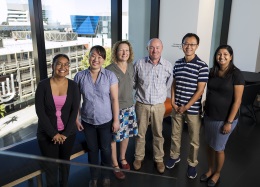27 March 2018
 In a highly successful collaboration with Sementis Limited and QIMR’s Berghofer Medical Research Institute, researchers at the University of South Australia have developed new technology set to deliver vaccines for many diseases and conditions, more cheaply and efficiently.
In a highly successful collaboration with Sementis Limited and QIMR’s Berghofer Medical Research Institute, researchers at the University of South Australia have developed new technology set to deliver vaccines for many diseases and conditions, more cheaply and efficiently.
The new approach has taken the world’s first and most successful vaccine against small pox - genetically altered it to improve its safety and efficacy - and created a new vaccine platform able to deliver multiple antigens to guard against serious infectious diseases, including the mosquito-borne zika and chikungunya viruses.
The new, altered vaccine, named the Sementis Copenhagen Vector (SCV), has been tested in preclinical proof of concept studies and been shown to provide protection against Chikungunya infection and its virus-induced complications and Zika virus – importantly preventing transmission of the virus to the foetus in pregnancy and also persistent infection of the testis.
The results of the research have been published today in the prestigious journal, Nature Communications and leader of the UniSA research team, Professor John Hayball says the outcome is the result of a highly effective collaboration with Sementis and QIMR over several years.
“We have now proved this is a very effective delivery vehicle for a vaccine protecting against multiple infectious diseases,” Prof Hayball says.
“Working together, we will continue to explore the potential of this platform to deliver multiple disease vaccines.
“This work puts us well on the way to delivering health benefits to millions of people around the world by providing more effective and accessible vaccines.
“The potential applications of this Australian research for a range of diseases and other conditions is enormous.”
In the next phase of this work, Sementis has been invited to use the preclinical services of the renowned US Government National Institute of Health’s Institute of Allergy and Infectious Diseases (NIAID) laboratories to evaluate the SCV vaccines in a non-human primate vaccination study.
The study will be funded by NIAID and bring the vaccine one step closer.
The SCV vaccine was produced using Chinese Hamster Ovary (CHO) cells, as are all Sementis’ SCV-based vaccines, which are routinely used for large scale manufacturing of biopharmaceuticals.
Sementis' Chairman, Maurice O'Shannassy, says the production of a viral vectored vaccine in a CHO cell substrate is a game-changer in terms of the improved economics of vaccine production and providing vaccines on a global scale.
“Previous vaccinia-based vaccine vector systems have used chicken embryo fibroblasts for manufacture, which is associated with a number of manufacturing and safety issues,” he says.
“Being able to manufacture a vectored vaccine using CHO cells is a world first and offers a number of advantages in the event of an outbreak, including rapid manufacture scale-up and cold chain (refrigeration) independent distribution capacity.”
Zika virus is a new and emerging virus that is transmitted by mosquitos where infection often causes no or mild symptoms similar to a very mild form of dengue fever. But in some adults, Zika virus can lead to Guillain Barre syndrome, a condition in which the immune system attacks the nerves.
Perhaps the most devastating manifestation of Zika virus infection is the array of congenital abnormalities in the foetuses and infants of women infected while pregnant.
Zika virus infection can persist in the male reproductive tract, where infected males can transmit the virus to sexual partners during this period of persistent infection, which dramatically increases the risk that an infected male inadvertently transmits the virus to a pregnant partner. Currently there are no antiviral drugs or vaccines for Zika virus.
Chikungunya is a viral infection caused by the chikungunya virus, also transmitted by mosquito, the very same mosquitos that transmit Zika virus.
In some cases, Chikungunya is asymptomatic – persons do not exhibit symptoms, but those with symptoms usually suffer from sudden fever and severe muscle and joint pain and in a few cases chronic joint pain may last for several weeks or months and may be accompanied by eye, gastrointestinal, neurological, and heart complications. Chikungunya is rarely fatal and treatment includes supportive care of symptoms as there are no antiviral treatment or a vaccine available.
You can read the full paper in Nature Communications
Media contact: Michèle Nardelli mobile 0418 823 673 email michele.nardelli@unisa.edu.au



